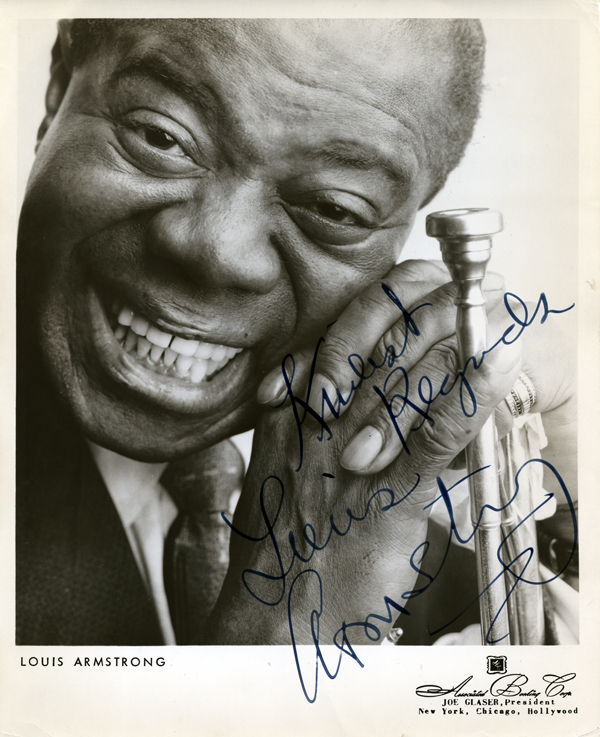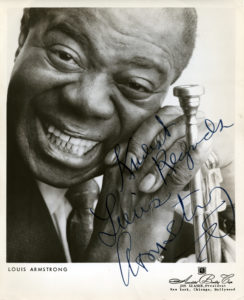Louis Armstrong
Renowned as a seminal figure in the evolution of jazz, Louis Armstrong is also considered one of the major artistic figures of the twentieth century.

Louisiana State Museum
A signed black and white publicity photograph of Louis Armstrong, 1960.
Louis Armstrong is renowned as both a seminal figure in the evolution of jazz and, more broadly, as one of the major artistic figures of the twentieth century. One of several important second-generation jazz musicians to emerge from New Orleans in the 1920s, he helped introduce jazz to the global cultural mainstream. Armstrong’s formidable technique and imaginative improvisations dramatically raised the level of musicianship among jazz soloists and vocalists alike. In later years, Armstrong also became a pop-music hero and beloved entertainer far beyond the somewhat limited audience for jazz.
Armstrong is held in high regard for several reasons. First, he was an agile, inventive instrumentalist, initially playing the cornet and later switching to the trumpet, a closely related instrument. His style was distinguished by its expressive and soulful feel, clear tone and broad range, and precise phrasing that included daring experiments with rhythm. A similar approach characterized Armstrong’s pioneering mastery of the wordless vocal style known as scat singing and, in a broader sense, his emotional, rhythmic approach to vocal phrasing.
Early Life
Although Armstrong stated that he was born on July 4, 1900, research by scholar Tad Jones revealed Armstrong’s actual birth date as August 4, 1901, in New Orleans. The son of Willie Armstrong and Mary Ann “Mayann” Miles of Boutté, he spent his early childhood with his grandmother, Josephine Armstrong. Louis Armstrong was raised on Jane Alley in a rough neighborhood known as “back of town,” near the present-day corner of Tulane Avenue and Broad Street. “I sure had a ball growing up there as a kid,” Armstrong told Life magazine interviewer Richard Meryman; “We were poor and everything like that, but music was all around you. Music kept you rolling.”
The music that Armstrong heard as a child was primarily a combination of blues, ragtime, military parade music, and spirituals. In the first decade of the twentieth century, this combination evolved into what would come to be called jazz. One important early source of music for Armstrong was a neighborhood joint known as the Funky Butt Hall. He was not allowed inside, but watched performances through chinks in its ramshackle walls. Armstrong was also exposed to the nascent jazz genre—as originated by the likes of Charles “Buddy” Bolden—at second-line parades, funeral processions, and other community gatherings. In addition, as a pre-teen, Armstrong had a job delivering coal in New Orleans’s infamous Storyville district. The brothels there employed some of the city’s best musicians, and Armstrong listened to them as much as possible.
At the age of eleven, Armstrong began singing on the streets with a loose aggregation of friends, accompanying them, at times, on a slide whistle. A year later, he was arrested for firing a pistol and remanded to the Colored Waifs Home. There he learned to play the cornet and read music, thanks to teacher/bandleader Peter Davis. Leaving this facility a year and a half later, Armstrong began performing at night while still doing manual labor by day. His reputation spread within the Black community and, at age eighteen, Armstrong was hired by trombonist Kid Ory to replace noted trumpeter Joseph “King” Oliver. Oliver, however, soon enticed Armstrong to join his band for a long-term engagement in Chicago. This marked Armstrong’s emergence as a full-time professional musician with a burgeoning reputation. His fame was further enhanced by recording with Oliver’s band in 1923. Armstrong was also a featured soloist on records by diverse artists, including the great blues singer Bessie Smith in 1924 and Jimmie Rodgers, the first star of country music, in 1930.
Professional Life
Between 1925 and 1928, Armstrong made recordings with two groups whose members overlapped: the Hot Fives and Hot Sevens. These recordings have come to be lauded as definitive statements of classic New Orleans jazz, although this term was not in use at the time. Highlights of these sessions included “Cornet Chop Suey,” “Struttin’ With Some Barbecue,” and “West End Blues,” with accompaniment by top players such as Kid Ory, clarinetist Johnny Dodds, drummer Baby Dodds, banjoist Johnny St. Cyr, and his then wife, Lil Armstrong. Armstrong’s recordings with pianist Earl “Fatha” Hines, during this era, are equally acclaimed.
For the next two decades Armstrong played in a wide variety of settings, both as a bandleader and a sideman. He worked in small combos, big bands, and the orchestra for the all-Black musical Hot Chocolates. Armstrong also appeared in films and recorded with such popular mainstream artists as Bing Crosby. As the big band era wound down after World War II, Armstrong returned to a smaller format with a band called the All-Stars. A recording of this band’s 1947 performance at New York’s Town Hall is highly acclaimed.
During the ensuing years, various configurations of this band included clarinetist Barney Bigard, drummer Big Sid Catlett, and trombonist Jack Teagarden. Armstrong’s popularity remained high, as exemplified by his number-one record, “Hello Dolly,” which briefly deposed The Beatles from the top of the pop charts in 1964.
In the social and cultural changes of mid-century America, Armstrong’s old-fashioned, gregarious performance style became passé in some circles. Armstrong’s 1949 appearance as King of Zulu during Mardi Gras further confounded some admirers. Not understanding the parade’s cultural complexities and implicit satire, many fans were puzzled by Armstrong’s appearance in blackface, the Krewe of Zulu’s traditional attire. At times critics—including modern jazz musicians and Black power advocates—dismissed Armstrong as an “Uncle Tom,” despite his outspoken criticism of President Eisenhower’s handling of the 1957 school desegregation crisis in Little Rock, Arkansas.
Such perceptions of Armstrong continued until his death in 1971. But a decade or so later, Armstrong was lionized by such young talents as the New Orleans trumpeter Wynton Marsalis. Since then, the earliest aspects of Armstrong’s repertoire have returned to considerable popularity. Today, Louis Armstrong is appreciated as one of the most important musicians to emerge from Louisiana.
